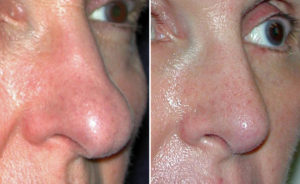Elective rhinoplasty, often called a nosejob, is a term used to describe surgical reshaping of the outside the nose. It is usually done because someone simply wants their nose to look different. In the past, rhinoplasty was something that only the wealthy or upper class pursued. It was not usually affordable for most people. Old rhinoplasty methods are also different from today. They used to consist of fairly drastic changes and the main outcome was making the nose much smaller. People at that time wanted smaller noses so everyone knew that they had their nose done. Such nose results produced long-term complications associated with eventual collapse of weakened bone and cartilages that make up the nose. This resulted in a classic nose appearance often referred to as ‘ski slope’ nose. As one aged the nose continued to sink in and almost all of these rhinoplasty results had problems breathing through their nose.
A good rhinoplasty result today is much different and the methods to get there are more refined and take into account one’s face. Today’s plastic surgeon strives to create a nose that fits the face and not a standard ‘cookie cutter’ approach. Since the nose is the focal point of the face, it should blend in and look like it belongs on that face. A short nose, for example, does not fit a long face. A large nose does not fit a small face. A small refined nose will not fit a man’s face in most cases. The key to a good rhinoplasty is to change the shape and proportions that stays in balance to other key facial areas such as the chin, cheeks, forehead, and jaw angles.

In some cases, changing the shape of the nose alone will still not give one ideal facial balance. As a result, changing other facial features at the same time may be beneficial. Most commonly, chin or cheek augmentation (bringing out other facial prominences) puts the face in better balance and makes the rhinoplasty result look more significant. Such artistic facial balancing takes an experienced plastic surgeon who can see the overall picture. Despite experience, I still will always look at these potential changes with computer imaging before surgery to be certain the patient will find what I think is what they really want.
Dr. Barry Eppley
Indianapolis, Indiana


